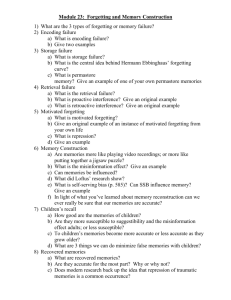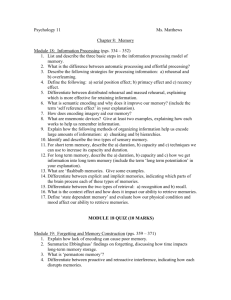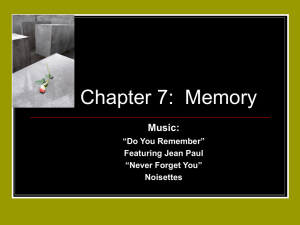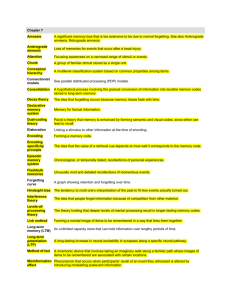Mod 19-Lecture - Phoenix Military Academy
advertisement
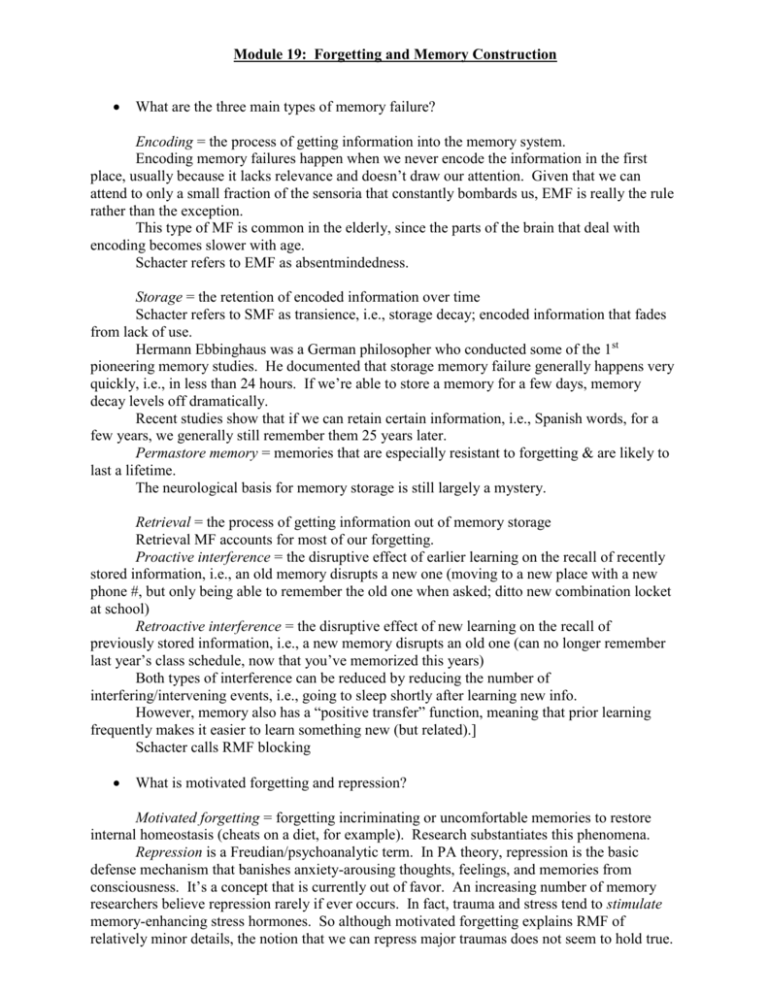
Module 19: Forgetting and Memory Construction What are the three main types of memory failure? Encoding = the process of getting information into the memory system. Encoding memory failures happen when we never encode the information in the first place, usually because it lacks relevance and doesn’t draw our attention. Given that we can attend to only a small fraction of the sensoria that constantly bombards us, EMF is really the rule rather than the exception. This type of MF is common in the elderly, since the parts of the brain that deal with encoding becomes slower with age. Schacter refers to EMF as absentmindedness. Storage = the retention of encoded information over time Schacter refers to SMF as transience, i.e., storage decay; encoded information that fades from lack of use. Hermann Ebbinghaus was a German philosopher who conducted some of the 1st pioneering memory studies. He documented that storage memory failure generally happens very quickly, i.e., in less than 24 hours. If we’re able to store a memory for a few days, memory decay levels off dramatically. Recent studies show that if we can retain certain information, i.e., Spanish words, for a few years, we generally still remember them 25 years later. Permastore memory = memories that are especially resistant to forgetting & are likely to last a lifetime. The neurological basis for memory storage is still largely a mystery. Retrieval = the process of getting information out of memory storage Retrieval MF accounts for most of our forgetting. Proactive interference = the disruptive effect of earlier learning on the recall of recently stored information, i.e., an old memory disrupts a new one (moving to a new place with a new phone #, but only being able to remember the old one when asked; ditto new combination locket at school) Retroactive interference = the disruptive effect of new learning on the recall of previously stored information, i.e., a new memory disrupts an old one (can no longer remember last year’s class schedule, now that you’ve memorized this years) Both types of interference can be reduced by reducing the number of interfering/intervening events, i.e., going to sleep shortly after learning new info. However, memory also has a “positive transfer” function, meaning that prior learning frequently makes it easier to learn something new (but related).] Schacter calls RMF blocking What is motivated forgetting and repression? Motivated forgetting = forgetting incriminating or uncomfortable memories to restore internal homeostasis (cheats on a diet, for example). Research substantiates this phenomena. Repression is a Freudian/psychoanalytic term. In PA theory, repression is the basic defense mechanism that banishes anxiety-arousing thoughts, feelings, and memories from consciousness. It’s a concept that is currently out of favor. An increasing number of memory researchers believe repression rarely if ever occurs. In fact, trauma and stress tend to stimulate memory-enhancing stress hormones. So although motivated forgetting explains RMF of relatively minor details, the notion that we can repress major traumas does not seem to hold true. How does memory construction work? Memory is actively constructed from many tiny pieces, not passively recorded as a whole event (more like a painting or jigsaw puzzle than a tape recording). If certain pieces of a memory are lost, we creatively fill in the blanks, sometimes accurately, often not. *Thus, memory is often misconstructed. Misinformation effect, i.e., incorporating misleading information into one’s memory of an event. Simply in the course of recounting an experience we fill in gaps with guesses and assumptions, that we then rewrite as memories. Even repeated imagining of nonexistent actions can create false memories. Think about doing B&B misinformation effect on p. 366. Significantly, the more time passé, the stronger the ME tends to be. Source misattribution or amnesia = confusing the source of information, i.e., retaining the image/info but not the context (Where have I seen this person before? Is this a memory or a fantasy?). It’s particularly common to confuse reality from imagination, i.e., did this happen or did I just envision it happening? Suggestibility = if exposed to subtle misinformation or bias, people will misremember events without being aware of it (Elizabeth Loftus & John Palmer’s experiment: cars “hit” versus “smashed” correlated with greater speed estimates & memories of broken glass). This is why courtroom testimony is so easily susceptable to manipulation Bias = refers to our beliefs coloring our recollections. Our beliefs color how we organize our memories (gender and racial prejudice). Memories are also biased by our moods. We tend associate good or bad events with their accompanying emotions (thus weddings are remembered happily, even if they weren’t) or in the reverse direction associate events by our current moods (for example currently depressed people more apt to recall parents as rejecting and guilt provoking; formerly depressed people see them as more accepting and warm). Thus our memories thus become “mood-congruent”. What is the relevancy of ME for children’s recall? Children are especially susceptible to suggestibility and the ME (Ceci & Bruck’s “going to the hospital with a mousetrap on your finger”). Children’s memories become more accurate over time, but preshoolers’s memories are inaccurate 90% of the time. It’s important to note that children aren’t purposefully lying; they’re simply confusing imagined & real events; or trying to please adults. This is particularly important to keep in mind re: incest & sexual abuse reports. Anatomically correct dolls themselves seem to suggest genital contact to children So any incest interviewing must be non-leading and ideally by a neutral person the child doesn’t know. Children’s testimony is likely to be more accurate if the interviewing adult: o Phrases question using words the child understands o Has no contact with the child prior to the investigation o Uses neutral language and does not ask leading or suggestive questions Research exposing children to misinformation shows that neither adults nor the children themselves are able to separate true from untrue child testimony. What are recovered memories? Recovered memories are memories, usually of a traumatic nature (i.e., sexual abuse), that have been repressed, then later recovered, usually through therapy, hypnosis or the like. Although memory repression has not been disproved, it does go against the usual pattern of trauma enhancing memory intensity. Much “recovery” therapy uses techniques of hypnosis, guided imagery, dream analysis and the like which is highly susceptible to suggestibility and ME. Remember imagined memories can be just as upsetting as real ones. In light of this, some of the current opinions of our time, i.e., “if you are unable to remember any specific instances . . . but still have a feeling that something abusive happened to you, it probably did” (Bass & Davis)” should be challenged. Memories before the age of 3 are especially suspect. This is not to say incest doesn’t happen or that that traumatic memories can’t be forgotten and later recovered. However, therapists must be very careful about suggestibility. Most traumatic memories are highly emotional and thus more likely to be strongly imprinted, then forgotten. In the name of healing their clients, therapists may be encouraging the confusion of fantasy and fact. Also suspect is hypnotically refreshed memories of crimes. What are Schacter’s “seven sins of memory”? The three sins of forgetting are: “absentmindedness”, “transience” and “blocking” which refer to encoding, storage and retrieval failure respectively. The three sins of distortion are: “misattribution”, “suggestibility” and “bias” The sin of intrusion is: “persistence”

